I think this furniture makeover from
See her original blog post for the Cinderella story version.
A lot of hard work but so worth it. Here is her letter:
Here’s a little backstory on this hutch. It was built by my Father-in-law back in the mid 80s as a gift to my Mother-in-law, who loves/loved the knotty pine/country look. After we were married, she gifted it to us as a wedding present. It used to have a large topper to the hutch that was really country-rific and oppressive and we tore that off about 2 years ago and replaced all of the hardware from brass to oil-rubbed bronze to give it a minor facelift. It was definitely an improvement, but not enough. We kept putting off the idea of “rebuilding” it simply because we knew it would be a great deal of work! Boy, were we right!
This is the obligatory before shot of the hutch. This is after the 2 year ago mini-makeover that we performed on the hutch. You can see the country-looking doors and the “baseboard” of the hutch which is also very curved and looks just overall country and not really our style at all. These were eye-sores to us as far as we were concerned and no matter how much paint we put on this thing, we would always notice these details, so they needed to be removed, changed, and updated.
We removed the “baseboard” and ripped up the sides of the hutch in the process, which is okay because we knew we would be painting anyway, so no worries. We filled in some of the damaged areas with wood filler and sanded to give it a nice smooth finish. Ahhh…such a relief to get rid of that!
We took some cues from places like Pottery Barn and Ballard Designs and just replaced the country looking baseboards with some planks of pine wood, which immediately updates it and takes it away from being country-rific to updated chic. We made sure to cut it to size, though we didn’t even miter the edges because we liked the less refined look of the edges just coming together on the end. We made sure to sand down EVERYthing really well at this point and roughed up the edges to give it a bit of a “weathered” look. Then, of course, we cleaned, primed, painted, painted some more, and polyurethaned everything really well.
(This step is a little above and beyond the traditional DIY and
I’ll do my best to explain my husband’s handiwork) My husband built the doors from scratch using pine. He essentially made square cuts on the ends of the pine and attached them into “frames” using pocket screws. He also drilled out on the backs of the frames little notches where the backers would go. This is probably an optional step – you could just design doors such that the backers would simply be nailed flat to the backs of the doors without the “notch”, but my husband definitely knows better than me!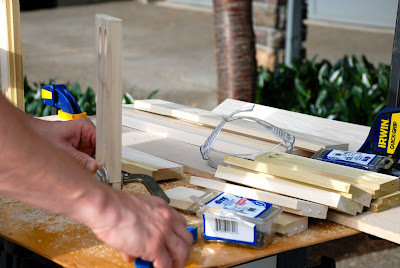
I’ll do my best to explain my husband’s handiwork) My husband built the doors from scratch using pine. He essentially made square cuts on the ends of the pine and attached them into “frames” using pocket screws. He also drilled out on the backs of the frames little notches where the backers would go. This is probably an optional step – you could just design doors such that the backers would simply be nailed flat to the backs of the doors without the “notch”, but my husband definitely knows better than me!
After the door “frames” were constructed, we nailed (thank goodness for nail guns, huh?) some cheap MDF fiber boards (really thin) to the backs of the doors. Then of course we sanded, primed, painted, polyurethaned, and let it dry for a little over 24 hours (I wanted it to be completely dry – my husband kept wanting to bring it all inside and finish off the job, but I kept telling him to be patient and be sure it was totally dry before we moved it anywhere!).
Then we rehung the doors using the same hardware we already had, though we did have to kind of jerryrig the doors a bit as we noticed that the openings were not all symmetrical – it’s a handmade piece to begin with, so you kind of expect that! When we drilled the holes for the handles we took a little tip from HGTV and a little tip for your readers if they are drilling “virgin” holes into new paint – put some painter’s tape over the area you will be drilling to protect the surrounding paint and wood. It also makes it easier to mark in pen the areas that need to be drilled without worrying about erasing your marks later on! Then you just carefully remove the tape and voila! A nice clean hole without any scuff marks.







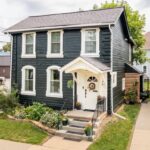

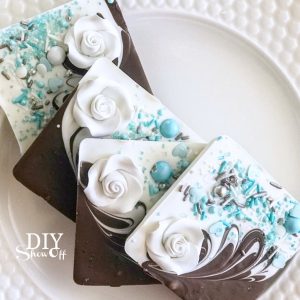
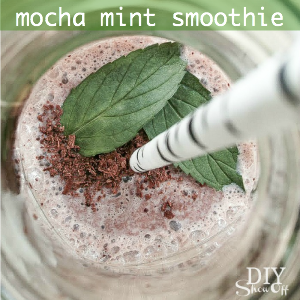

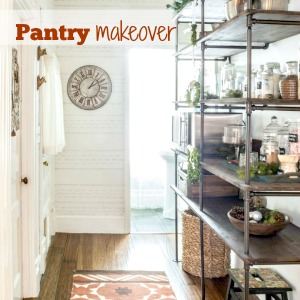
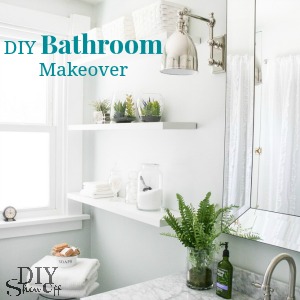


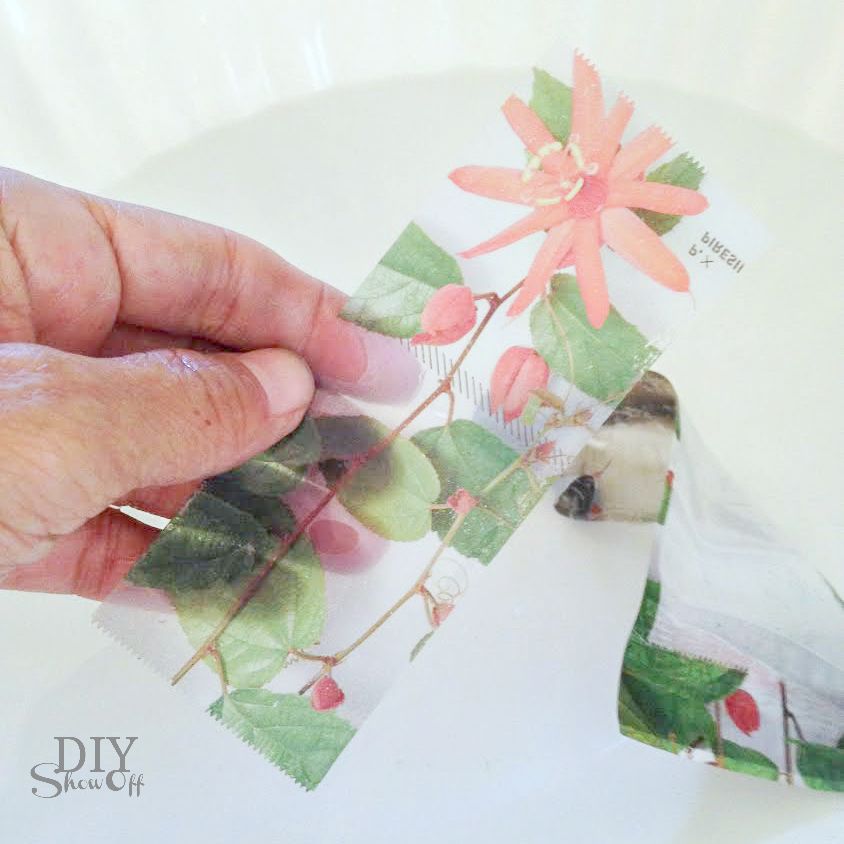
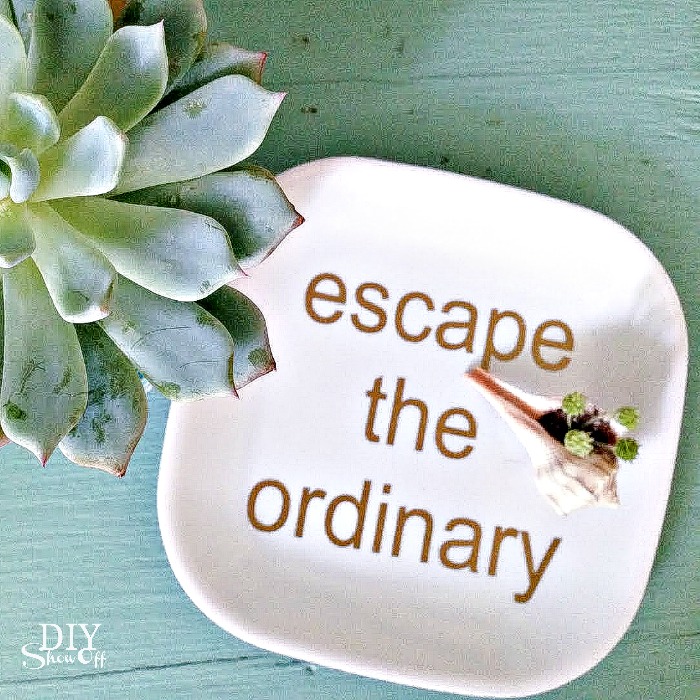
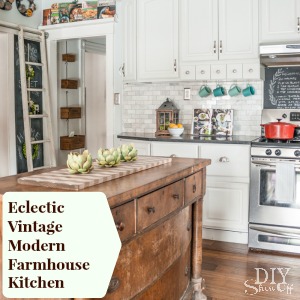

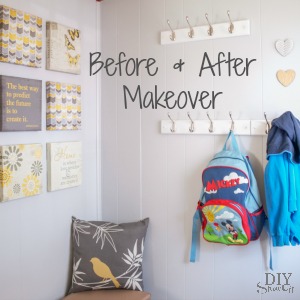





Personally, I think the baseboard was pretty with its curves. With the new doors and paint, it would have been a beautiful piece. Now it's a bit cookie cutter. It's still an amazing transformation though.
Great work taking this from countrific to urban chic. I am only now becoming brave enough to paint wood, but have not yet jumped in. Thanks for all of the photos.
wow!! what a difference!
Beautiful job.
blessings
barbara jean
Oh, wow!!! Love the "after"! 🙂
Thanks so much, Roeshel for doing this! It was a fun project and I'm so happy to share it with others! Thanks for the opportunity to be a contributor to your site and thanks to everyone for their positive feedback!
Lindsay
http://tellerallaboutit.wordpress.com
Reading comments makes me smile. 🙂
I featuring DIY project submissions – I could look at transformations all day long – so thanks Lindsay for showing off yours and for sharing The DIY Show Off with your readers! 🙂
Roeshel
Great transformation. Can you imagine how much money she saved reworking the existing piece rather than buying new.
Clean, classic and white. I love it.
Clean, classic and white. I love it.
Wow, love the new look!!